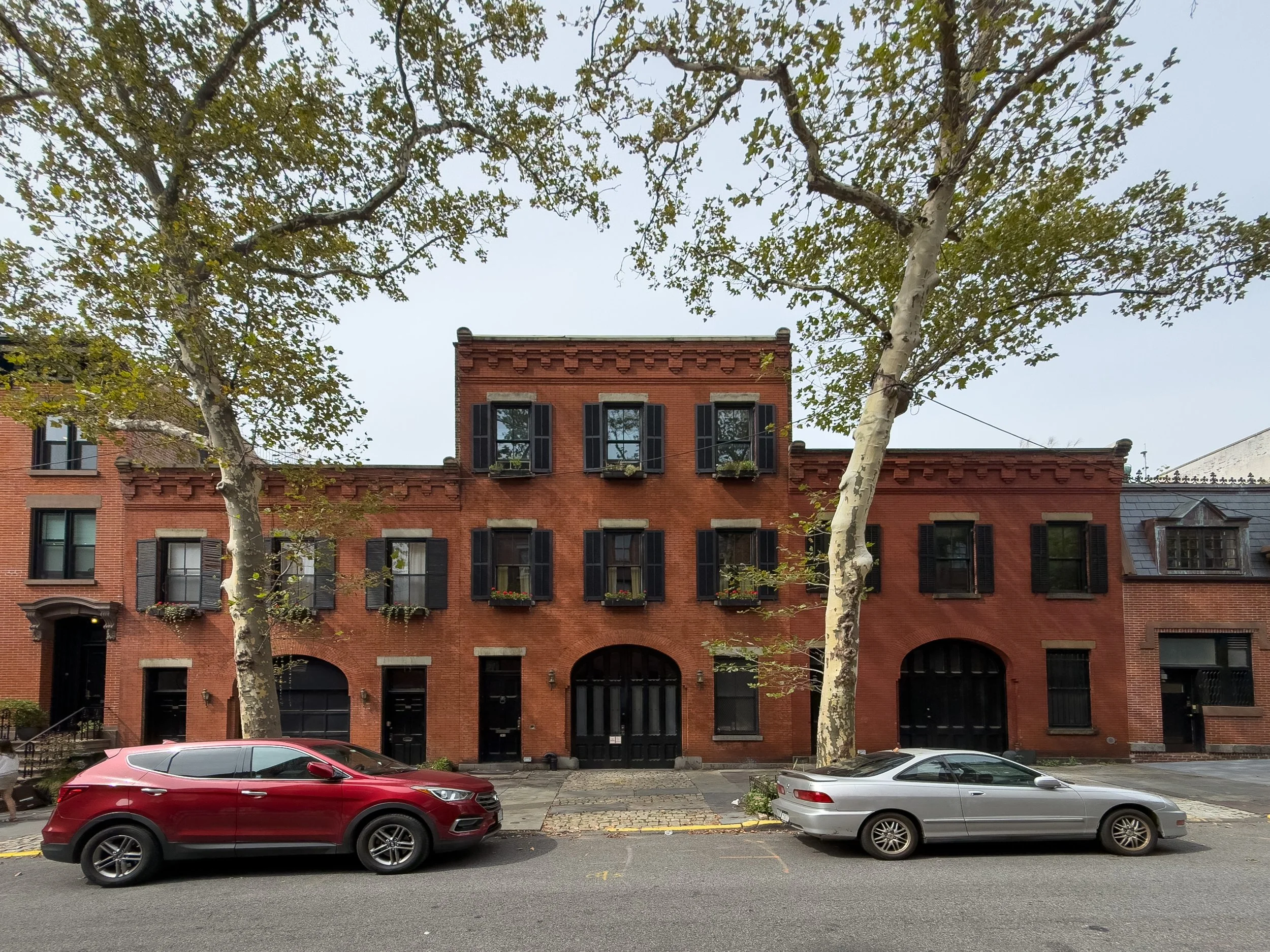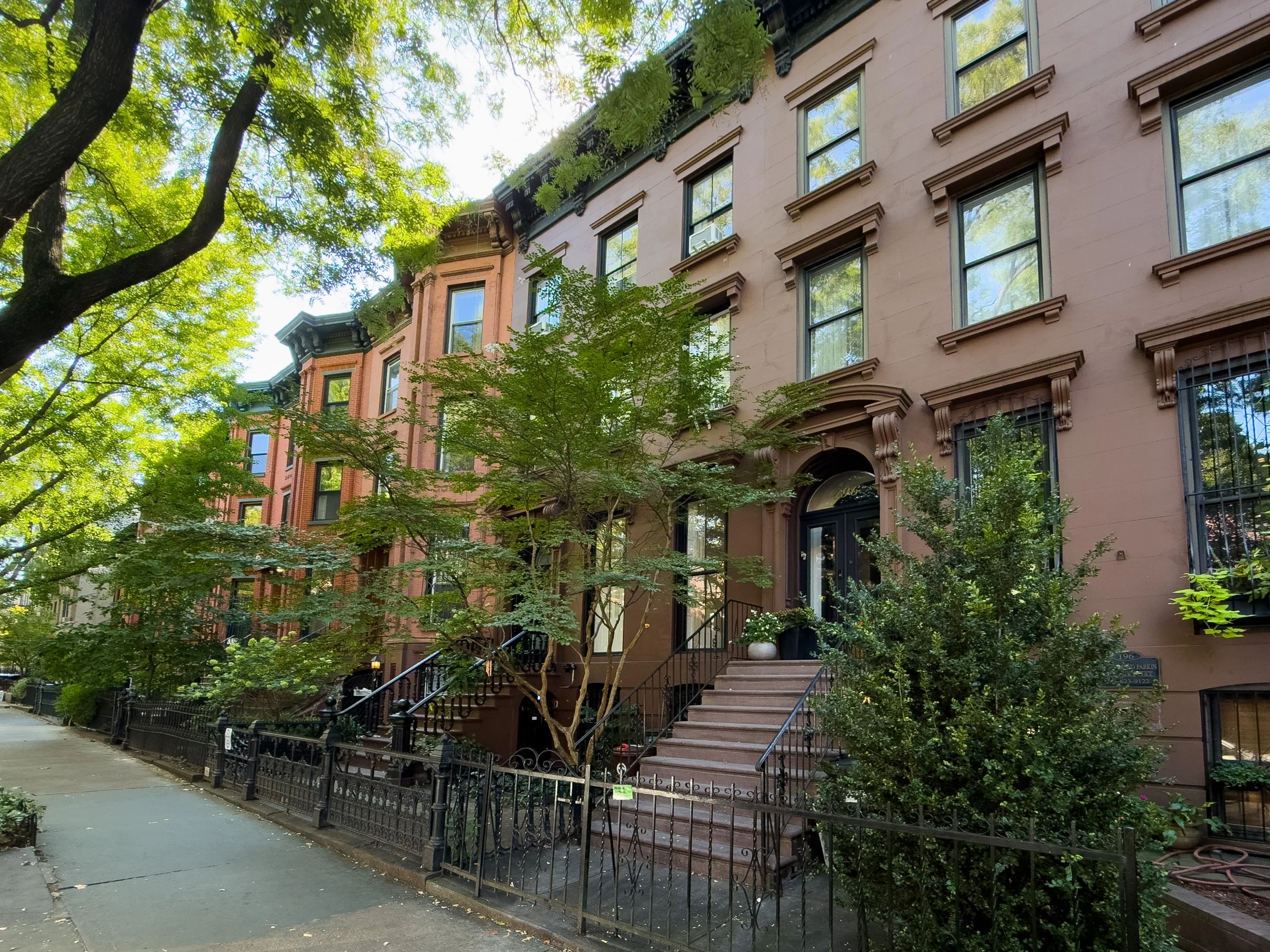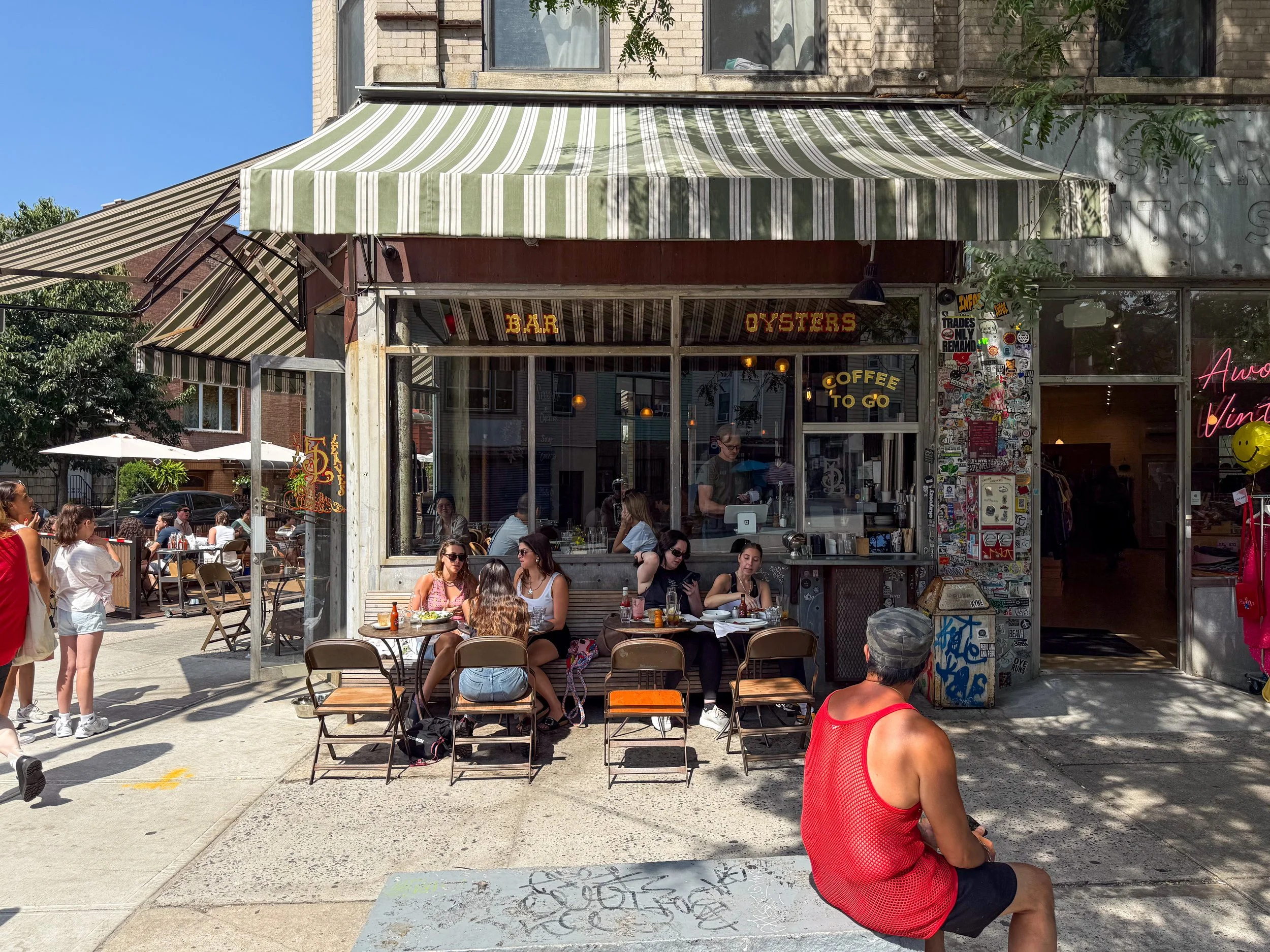Park Slope, Brooklyn
Park Slope combines architectural beauty, neighborhood pride, and a rare balance of green space and city convenience. From tree-lined blocks to Prospect Park’s open meadows, it offers a lifestyle that feels both classic and contemporary.
Park Slope
1. Neighborhood: Classic Brooklyn brownstone enclave; Prospect Park; tree-lined streets, historic architecture, and enduring neighborhood charm.
2. Conveniences: Cafés, grocers, and shops along 5th and 7th Avenues; Prospect Park and Grand Army Plaza within walking distance.
3. Transit: (2)(3)(4)(B)(D)(Q)(F)(G)(N)(R)(W) lines via 7th Ave, 15th St–Prospect Park, Citi Bike, and Prospect Expressway access.
4. Real Estate: Brownstones, limestone townhouses, prewar co-ops, and boutique condos; limited inventory with steady long-term appreciation and strong end-user demand.
The Vibe at a Glance
Park Slope blends architectural grace with daily livability — elegant brownstones, leafy avenues, and a strong sense of community at its core. Prospect Park anchors neighborhood life, while cafés, bookstores, and local markets line its main avenues. It’s a neighborhood that feels established yet full of motion — a timeless slice of Brooklyn where history, creativity, and everyday comfort coexist. Exploring Park Slope real estate or planning a future sale? Get tailored insights on pricing, timing, and neighborhood trends — let’s start the conversation.
Located in Brooklyn, NYC 11215
Neighborhood
North to South: Flatbush Ave. to Prospect Ave.
East to West Prospect Park N. to 4th Ave.
Nearby Neighborhoods: Prospect Heights, Gowanus, Boerum Hill, Greenwood Heights
MTA Subways
(2) (3) (4) (B) (D) (Q) (F) (G) (N) (R) (W)
Commute Times
Financial District: 32m train, 25m car
Grand Central: 47m train, 44m car
Union Square: 38m train, 41m car
Williamsburg: 45m train, 27m car
Park Slope
Nestled along the western edge of Prospect Park, Park Slope is one of Brooklyn’s most established and admired neighborhoods. Its tree-lined avenues, landmark brownstones, and family-friendly atmosphere create a setting that feels both classic and current. Defined by walkability, architectural beauty, and a strong sense of community, Park Slope blends the grace of 19th-century Brooklyn with the conveniences of modern city living.
Known for its quiet side streets, cultural access, and proximity to green space, the neighborhood attracts long-term residents who value stability and connection. From stoop-lined brownstones to elegant prewar co-ops overlooking Prospect Park, Park Slope offers a lifestyle rooted in everyday livability — refined, vibrant, and unmistakably Brooklyn.
Vibe and Atmosphere
Park Slope’s charm lies in its rhythm: calm, neighborly, and architecturally rich. Elegant brownstones and limestone townhouses line streets shaded by century-old trees, while corner cafés and bookstores maintain a sense of small-scale intimacy rare in New York. The neighborhood’s historic district showcases some of Brooklyn’s best-preserved architecture — Romanesque Revival, Neo-Grec, and Renaissance Revival homes that give each block a cohesive warmth.
More than almost any Brooklyn neighborhood, Park Slope feels family-oriented — stroller-friendly sidewalks, playgrounds at every turn, and a community rhythm that slows the city’s pace without dulling its energy. It’s a neighborhood that balances quiet routine and daily bustle — where neighbors chat outside coffee shops, friends linger on stoops, and local life unfolds at a measured, human pace.
Prospect Park anchors that balance. Spanning 585 acres of meadows, woodlands, and trails — bordered by West Drive and East Drive — it serves as both a gathering place and community anchor, tying the neighborhood’s rhythm to the natural world. Morning joggers and cyclists, weekend markets, and summer concerts at the Lena Horne Bandshell reinforce Park Slope’s appeal: a quintessential Brooklyn neighborhood that feels self-contained yet deeply connected to the life of the city.
Amenities and Conveniences
Daily life in Park Slope centers on comfort and accessibility. Seventh and Fifth Avenues form its commercial spine, lined with grocers, pharmacies, fitness studios, and independent shops. Nearby Whole Foods Market in Gowanus and Union Market add large-format options, while neighborhood staples like Park Slope Food Coop, Foodtown of Park Slope, and Russo’s Mozzarella & Pasta provide local variety and community connection. The result is a walkable district where most daily needs can be met within just a few blocks.
Prospect Park adds extraordinary convenience — playgrounds, sports fields, the Brooklyn Botanic Garden, and the Brooklyn Museum are all a short walk or bike ride away. Health services are anchored by NewYork-Presbyterian Brooklyn Methodist Hospital, while numerous childcare centers and community organizations reflect the neighborhood’s family orientation.
Despite its brownstone calm, Park Slope offers the accessibility of an urban hub: errands are local, green space is abundant, and community engagement remains a defining feature.
Dining and Shopping
Park Slope’s dining scene blends neighborhood warmth with an impressive range of restaurants and cafés. Al di La Trattoria remains a cornerstone — one of Brooklyn’s most enduring Italian destinations — while Fausto and Stone Park Café keep the neighborhood’s culinary standards high. Haenyeo offers inventive Korean small plates, and Winner draws lines for its bakery by day and seasonal menus by night. Along 5th and 7th Avenues, a mix of casual eateries and wine bars — including Fonda, Brooklyn Burgers & Beer, Al Di Là Trattoria, and Terrace Restaurant & Bakery — make it easy to dine well without leaving the neighborhood.
Brunch and coffee culture are part of daily life here: Café Regular, Couleur Café, and Root Hill Café remain local fixtures. Ice cream lovers head to Ample Hills Creamery, and those seeking classic sweets stop at Colson Patisserie or Ladybird Bakery. Together, these long-standing and newer spots give Park Slope a mix of neighborhood comfort and destination dining that reflects its balance of tradition and evolution.
Shopping in Park Slope follows the same rhythm — local, independent, and community-driven. Along 5th and 7th Avenues, you’ll find Community Bookstore, Powerhouse on 8th, and Books Are Magic, each contributing to Brooklyn’s thriving literary scene. Specialty retailers like Brooklyn Mercantile and Goldie’s Natural Beauty highlight design, wellness, and sustainable goods. Boutiques such as Diana Kane, Something Else on Fifth, and Antoinette Brooklyn add curated fashion, while Beacon’s Closet offers designer resale with a distinctly Park Slope sensibility.
Children’s shops, toy stores, and home design boutiques underscore the neighborhood’s family-oriented character, while Park Slope Food Co-op — one of the oldest and largest in the country — remains a community landmark and reflection of local values. Weekend farmers markets, including the Grand Army Plaza Greenmarket, extend the neighborhood’s connection to local food and craft makers.
Together, Park Slope’s dining and retail life feel distinctly self-contained — sophisticated but approachable, where everyday convenience and thoughtful craft coexist on nearly every block.
Transportation
Park Slope is among Brooklyn’s most accessible neighborhoods. The (2) (3) (4) (B) (D) (Q) (F) (G) (N) (R) and (W) lines provide direct service to Manhattan and other boroughs via stations at 7th Avenue, 15th Street–Prospect Park, and Atlantic Terminal–Barclays Center. Citi Bike docks line nearly every avenue, and frequent bus routes connect to Downtown Brooklyn, Carroll Gardens, and Red Hook. For drivers, quick access to the Prospect Expressway and Brooklyn–Queens Expressway adds flexibility, while most residents enjoy a walkable commute to nearby schools, cafés, and Prospect Park itself.
Schools
Park Slope is known for its concentration of respected schools. Public options include P.S. 321 William Penn, P.S. 39 Henry Bristow, and M.S. 51 William Alexander, all highly rated. Private and independent choices — Poly Prep Lower School, Berkeley Carroll School, and St. Saviour Catholic Academy — draw families from across Brooklyn. The neighborhood’s emphasis on education and community involvement makes it one of the most sought-after areas for families seeking long-term stability.
Real Estate Insights
Park Slope’s housing market continues to demonstrate strength and long-term stability. Its architectural mix — brownstones, limestone townhouses, prewar co-ops, and boutique condominiums — defines one of Brooklyn’s most desirable residential landscapes. While many brownstones have been restored as single-family homes, others are configured as multi-family properties, balancing historic charm with investment potential.
Newer developments near Fourth Avenue and along the neighborhood’s southern edge have diversified options for buyers seeking modern finishes, elevators, and amenities — a contrast to the prewar walk-ups and classic co-ops that dominate the core blocks. Overall, inventory remains limited. Steady demand and low turnover continue to support premium pricing, especially for homes close to Prospect Park or within the landmarked North Slope.
Sales Market At A Glance (2025)
Average Home Value (ZHVI): $1,524,577 (Zillow)
Median List Price: $1.63M (Zillow / StreetEasy)
Median Sale Price: (Q4 2025) $1.5 M (PropertyShark)
1-Bedroom: $795K; 2-Bedroom $1.39M; 3-Bedroom $2.25M (StreetEasy)
Median Days on Market: 49 days (Zillow)
Source: Property Shark, Street Easy, & Zillow (2025). Zillow’s Home Value Index (ZHVI) reflects average home values across all properties, using seasonally adjusted measures that incorporate recent sales and market data.
Trends
Park Slope’s 2025 market shows measured growth driven by consistent demand for historic brownstones and well-renovated co-ops. Median sale prices rose roughly 14 percent year-over-year, supported by limited inventory and continued buyer confidence in Brooklyn’s most established corridor. Condominiums averaged around $1.5 million, down slightly from 2024 as supply increased along Fourth Avenue, while townhouses and single-family homes held steady at premium levels near $2.8 million.
Co-ops — a core part of Park Slope’s housing stock — showed healthy momentum with median prices around $1.3 million, reflecting both renovation activity and continued end-user demand. While some listings allowed modest negotiation, the neighborhood remains a steady, owner-occupied market anchored by heritage architecture, proximity to Prospect Park, and strong school zones.
Final Thoughts
Park Slope represents Brooklyn at its most complete — architectural beauty, community warmth, and urban convenience all in one place. From its historic brownstones and lively avenues to the open meadows of Prospect Park, the neighborhood balances tradition and modernity with effortless charm. Residents value its sense of stability and self-sufficiency: schools within walking distance, local cafés that remember your order, and tree-lined blocks that make the city feel smaller in the best possible way. Whether you’re drawn by its real estate legacy or its everyday rhythm, Park Slope endures as one of New York’s most livable and beloved neighborhoods.
Thinking of buying or selling in Park Slope? Get tailored insights on pricing, timing, and strategy — or request a complimentary Comparative Market Analysis (CMA). Reach out — let’s start the conversation.
For in-depth guides on topics like buyer financing, NYC closing costs, pricing strategies, and more — visit the Resources & Insights hub for resources designed to help guide buyers and sellers in the Park Slope real estate market.


























